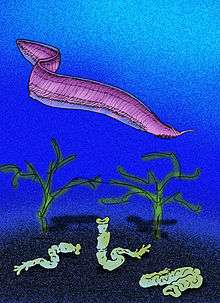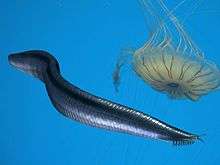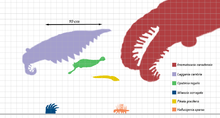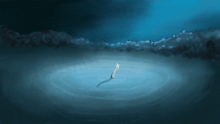Pikaia
Pikaia gracilens is an extinct, primitive chordate animal known from the Middle Cambrian Burgess Shale of British Columbia.[1] Sixteen specimens are known from the Greater Phyllopod bed, where they comprised 0.03% of the community.[2] It resembled the lancelet and perhaps swam much like an eel.
| Pikaia | |
|---|---|
 | |
| Life reconstruction of Pikaia gracilens | |
| Scientific classification | |
| Kingdom: | Animalia |
| Phylum: | Chordata |
| Family: | †Pikaiidae |
| Genus: | †Pikaia Walcott, 1911 |
| Species: | †P. gracilens |
| Binomial name | |
| †Pikaia gracilens Walcott, 1911 | |
Description

Pikaia was a primitive chordate that lacked a well-defined head and averaged about 1 1⁄2 inches (38 mm) in length. Once thought to be closely related to the ancestor of all vertebrates, it has for that reason received particular attention among the multitude of animal fossils found in the famous Burgess Shale in the mountains of British Columbia, Canada. Pikaia had a pair of large, antenna-like tentacles on its head, and a series of short appendages, which may be linked to gill slits, on either side of its head. In these ways, it differs from the modern lancelet. The "tentacles" on its head may be comparable to those in the present-day hagfish, a jawless chordate.
Although primitive, Pikaia shows the essential prerequisites for vertebrates. When alive, Pikaia was a compressed, leaf-shaped animal with an expanded tail fin; the flattened body is divided into pairs of segmented muscle blocks, seen as faint vertical lines. The muscles lie on either side of a flexible structure resembling a rod that runs from the tip of the head to the tip of the tail.[3] It likely swam by throwing its body into a series of S-shaped, zigzag curves, similar to the movement of eels; fish inherited the same swimming movement, but they generally have stiffer backbones. These adaptations may have allowed Pikaia to filter particles from the water as it swam along. Pikaia was probably a slow swimmer, since it lacked the fast-twitch fibers that are associated with rapid swimming in modern chordates.[4]
Conway Morris and Caron (2012) published an exhaustive description based on all 114 of the known fossil specimens; they discovered new and unexpected characteristics that they recognized as primitive features of the first chordate animals. On the basis of these findings, they constructed a new scenario for chordate evolution.[5] Subsequently, Mallatt and Holland reconsidered Conway Morris and Caron's description, and concluded that many of the newly recognized characters are unique, already-divergent specializations that would not be helpful for establishing Pikaia as a basal chordate.[6]
Discovery

P. gracilens was discovered by Charles Walcott and first described by him in 1911. It was named after Pika Peak, a mountain in Alberta, Canada. Based on the obvious and regular segmentation of the body, Walcott classified it as a polychaete worm.
During his re-examination of the Burgess Shale fauna in 1979, paleontologist Simon Conway Morris placed P. gracilens among the chordates, making it perhaps the oldest known ancestor of modern vertebrates. He did this because it seemed to have a very primitive, proto-notochord, however, the status of Pikaia as a chordate is not universally accepted; its preservational mode suggests that it had cuticle, which is uncharacteristic of the vertebrates [7] (although characteristic of other cephalochordates); further, its tentacles are unknown from other vertebrate lineages.[7] The presence of earlier chordates among the Chengjiang, including Haikouichthys and Myllokunmingia, appears to show that cuticle is not necessary for preservation, overruling the taphonomic argument,[8] but the presence of tentacles remains intriguing, and the organism cannot be assigned conclusively, even to the vertebrate stem group. Its anatomy closely resembles the modern creature Branchiostoma.[9]
Evolution

Much debate on whether Pikaia is a vertebrate ancestor, its worm-like appearance notwithstanding, exists in scientific circles. It looks like a worm that has been flattened sideways. The fossils compressed within the Burgess Shale show chordate features such as traces of an elongate notochord, dorsal nerve cord, and blocks of muscles (myotomes) down either side of the body – all critical features for the evolution of the vertebrates.
The notochord, a flexible rod-like structure that runs along the back of the animal, lengthens and stiffens the body so that it can be flexed from side to side by the muscle blocks for swimming. In the fish and all subsequent vertebrates, the notochord forms the backbone (or vertebral column). The backbone strengthens the body, supports strut-like limbs, and protects the vital dorsal nerve cord, while at the same time allowing the body to bend.
A Pikaia lookalike, the lancelet Branchiostoma, still exists today. With a notochord and paired muscle blocks, the lancelet and Pikaia belong to the chordate group of animals from which the vertebrates descended. Molecular studies have refuted earlier hypotheses that lancelets might be the closest living relative to the vertebrates, instead favoring tunicates in this position;[10] other extant and fossil groups, such as acorn worms and graptolites, are more primitive.[lower-alpha 1]
The presence of a creature as complex as Pikaia some 530 million years ago reinforces the controversial view that the diversification of life must have extended back well before Cambrian times – perhaps deep into the Precambrian.[3] The discovery of Metaspriggina, a primitive fish of similar age which seems to have already started to develop a jaw and the presence of conodonts, the teeth of an extinct type of fish belonging to the Agnatha some 20 MA before Pikaia, does provide support for that view.
Development of the head
The first sign of head development, cephalization, is seen in chordates such as Pikaia and Branchiostoma. It is thought that development of a head structure resulted from a long body shape, a swimming habit, and a mouth at the end that came into contact with the environment first, as the animal swam forward. The search for food required ways of continually testing what lay ahead so it is thought that anatomical structures for seeing, feeling, and smelling developed around the mouth. The information these structures gathered was processed by a swelling of the nerve cord (efflorescence) – the precursor of the brain. Altogether, these front-end structures formed the distinct part of the vertebrate body known as the head.[3]
See also
Notes
- Acorn worms are classified as hemichordates, which have a notochord-like structure only at the early stage of their lives.
References
- Briggs, Derek E. G.; Locatelli, Emma R.; Petermann, Holger; Anderson, Ross P.; Clark, Elizabeth G.; Vogt, Stefan; Finney, Lydia; Soriano, Carmen; Whalen, Christopher D. (2016). "The 'Tully monster' is a vertebrate". Nature. 532 (7600): 496–499. doi:10.1038/nature16992. ISSN 1476-4687. PMID 26982721.
- "Pikaia gracilens" Burgess Shale Fossil Gallery. Virtual Museum of Canada. 2011.
- Palmer, D., (2000). The Atlas of the Prehistoric World. London: Marshall Publishing Ltd. p66-67.
- Lacalli, T. (2012). "The Middle Cambrian fossil Pikaia and the evolution of chordate swimming". EvoDevo. 3 (1): 12. doi:10.1186/2041-9139-3-12. PMC 3390900. PMID 22695332.
- Conway Morris, S.; Caron, J. B. (2012) "Pikaia gracilens Walcott, a stem-group chordate from the Middle Cambrian of British Columbia". Biological Reviews 87: 480-512.
- Mallatt, J.; Holland, N. D. (2013) "Pikaia gracilens Walcott: stem chordate, or already specialized in the Cambrian?" Journal of Experimental Zoology, Part B, Molecular and Developmental Evolution 320B: 247-271.
- Butterfield, N. J. (1990), "Organic preservation of non-mineralizing organisms and the taphonomy of the Burgess Shale", Paleobiology, 16 (3): 272–286, doi:10.1017/S0094837300009994, JSTOR 2400788
- Conway Morris, S. (2008), "A Redescription of a Rare Chordate, Metaspriggina walcotti Simonetta and Insom, from the Burgess Shale (Middle Cambrian), British Columbia, Canada", Journal of Paleontology, 82 (2): 424–430, doi:10.1666/06-130.1, retrieved 2009-04-28
- Donoghue, P. C. J.; Purnell, M. A. (2005), "Genome duplication, extinction and vertebrate evolution" (PDF), Trends in Ecology & Evolution, 20 (6): 312–319, doi:10.1016/j.tree.2005.04.008, PMID 16701387, archived from the original (PDF) on 2008-12-17, retrieved 2008-11-06
- Delsuc; et al. (2008). "Additional molecular support for the new chordate phylogeny" (PDF). Genesis. 46 (11): 592–604. doi:10.1002/dvg.20450. PMID 19003928.
Further reading
- Bishop, A., Woolley, A. and Hamilton, W. (1999) Minerals, Rocks and Fossils. London: Phillip's
- Lacalli T. (2012) "The Middle Cambrian fossil Pikaia and the evolution of chordate swimming". EvoDevo 3: 12. doi:10.1186/2041-9139-3-12
- Conway Morris, Simon. 1998. The Crucible of Creation: The Burgess Shale and the Rise of Animals. Oxford University Press, New York, New York.
- Gould, Stephen Jay. 1989. Wonderful Life: The Burgess Shale and the Nature of History. W. W. Norton, New York, NY.
- Norman, D. (1994) Prehistoric Life: the Rise of the Vertebrates, London: Boxtree
- Sheldon, P., Palmer D., Spicer, B. (2001). Fossils and the History of Life. Aberystwyth: Cambrian Printers/The Open University. p. 41-42.
External links
| Wikimedia Commons has media related to Pikaia. |
- "Pikaia gracilens". Burgess Shale Fossil Gallery. Virtual Museum of Canada. 2011.
- La evolución de las especies: ¿por qué sobrevivió Pikaia? (Spanish)
- Fossils of the Burgess Shale - Middle Cambrian
- Pikaia gracilens Walcott, a stem-group chordate from the Middle Cambrian of British Columbia